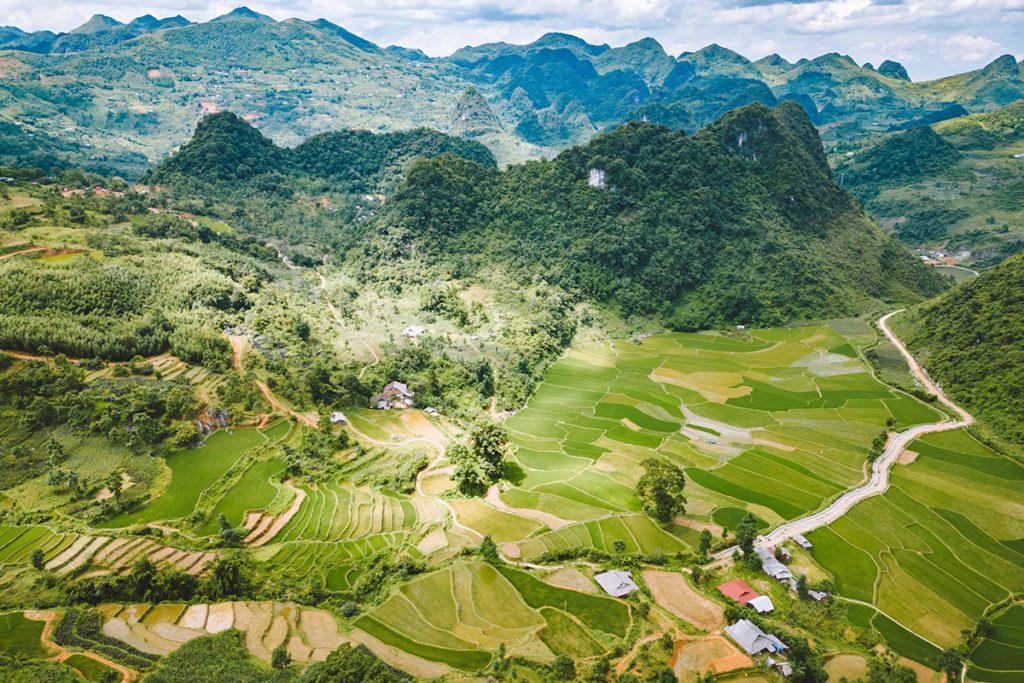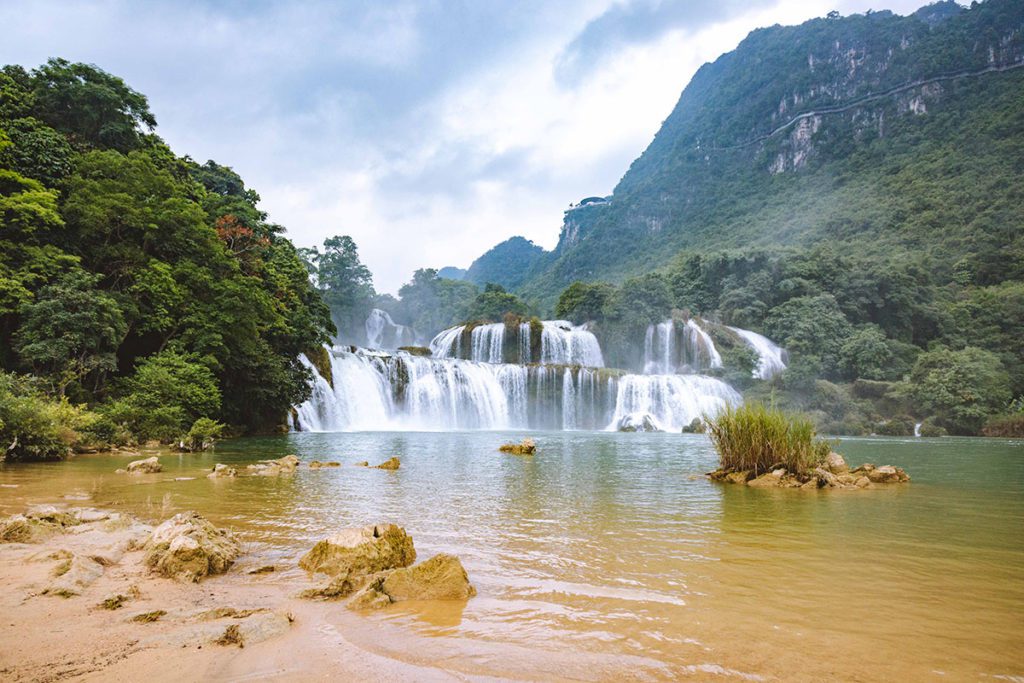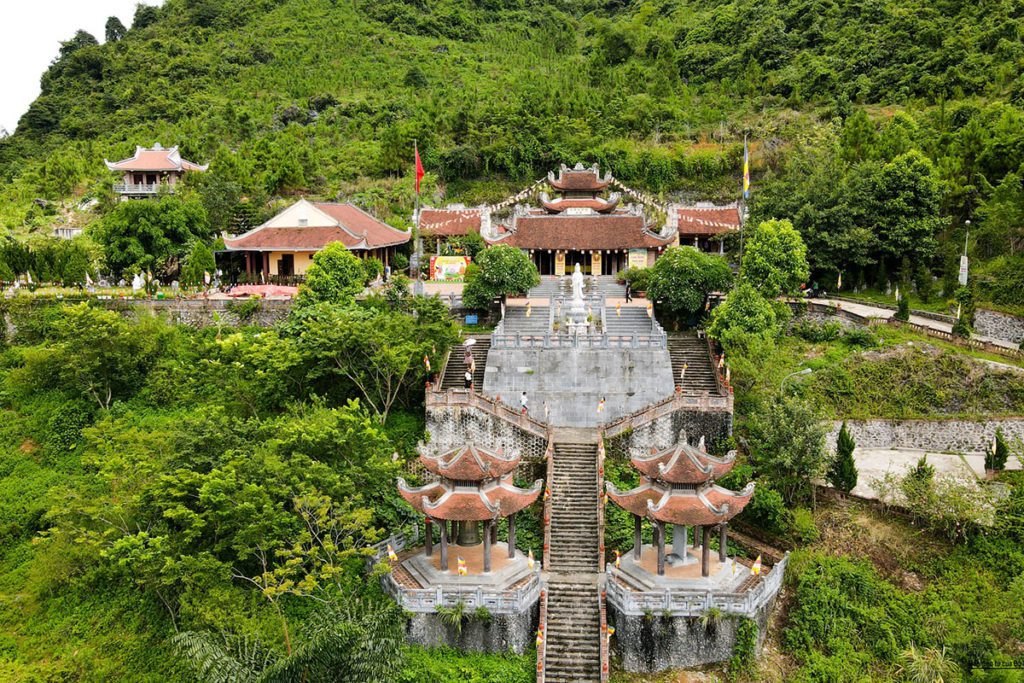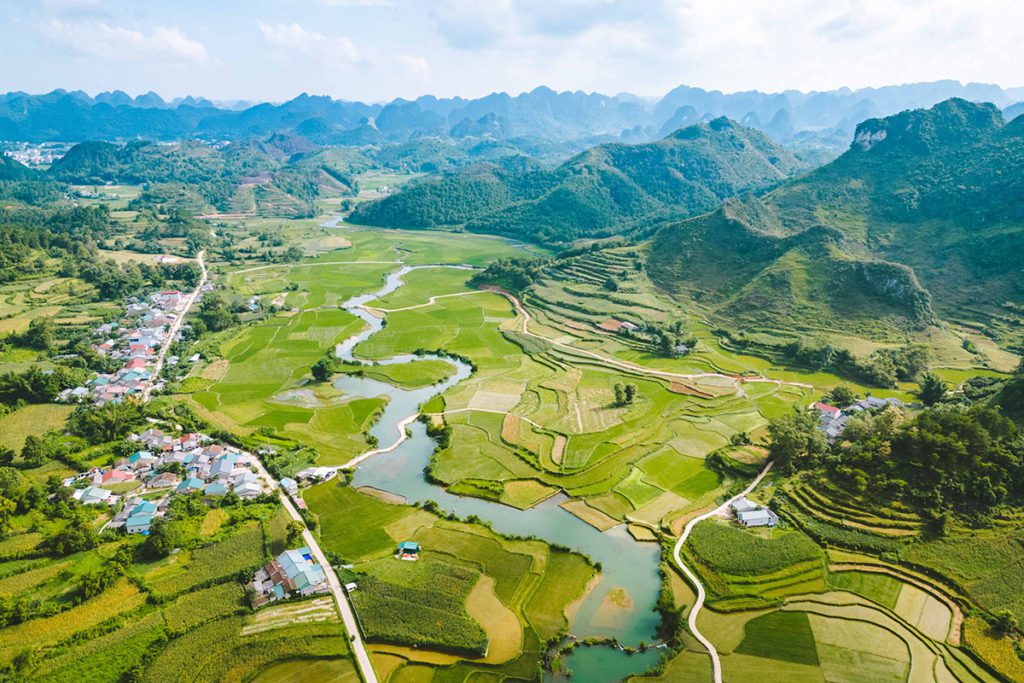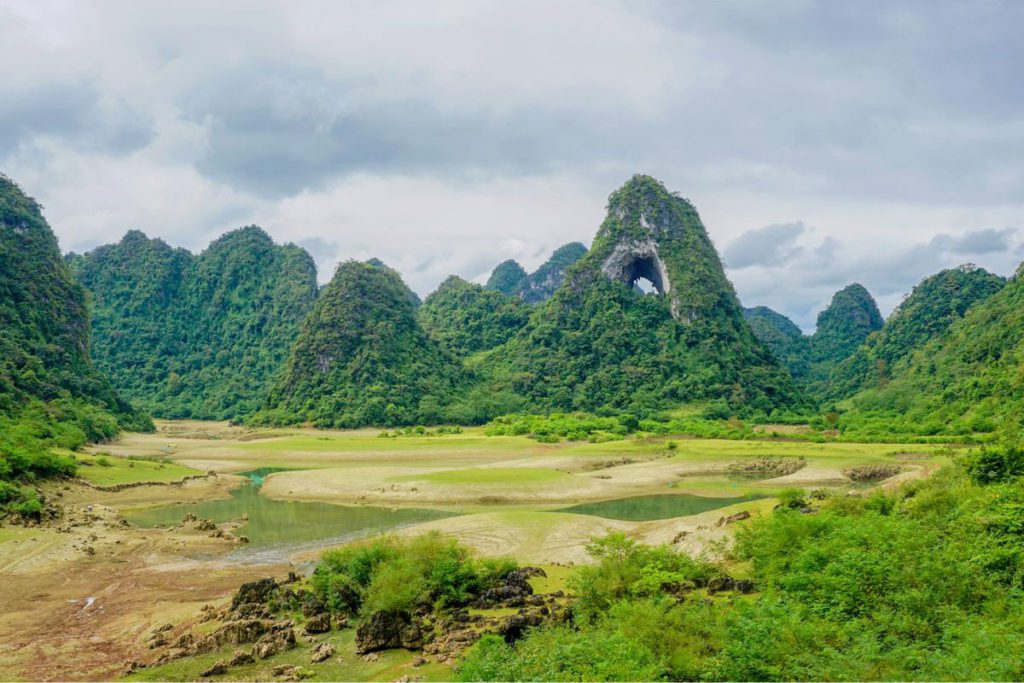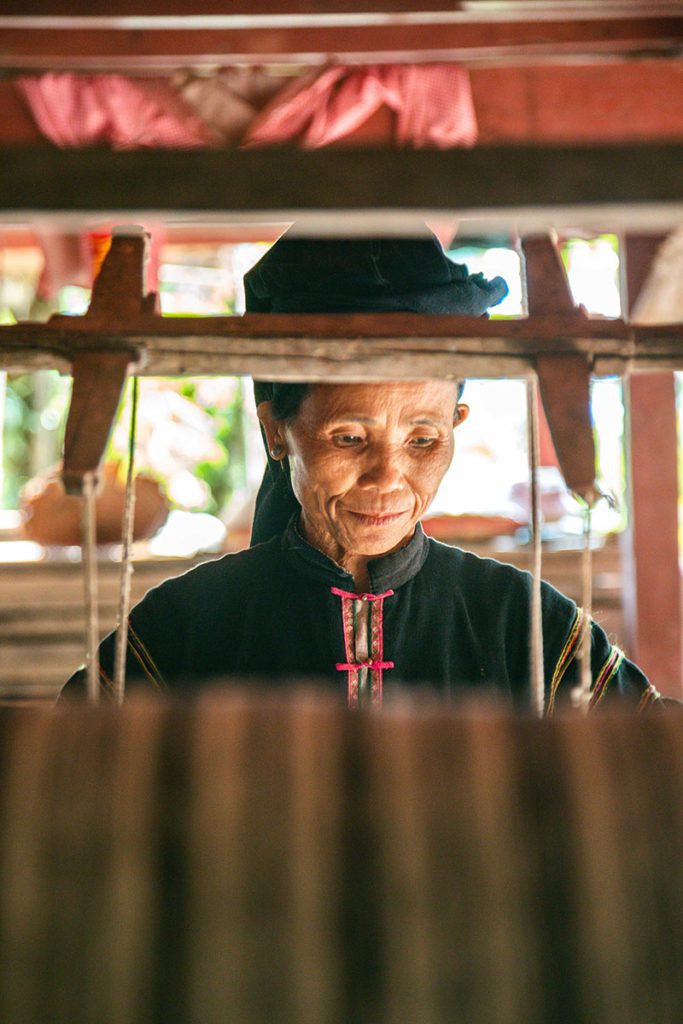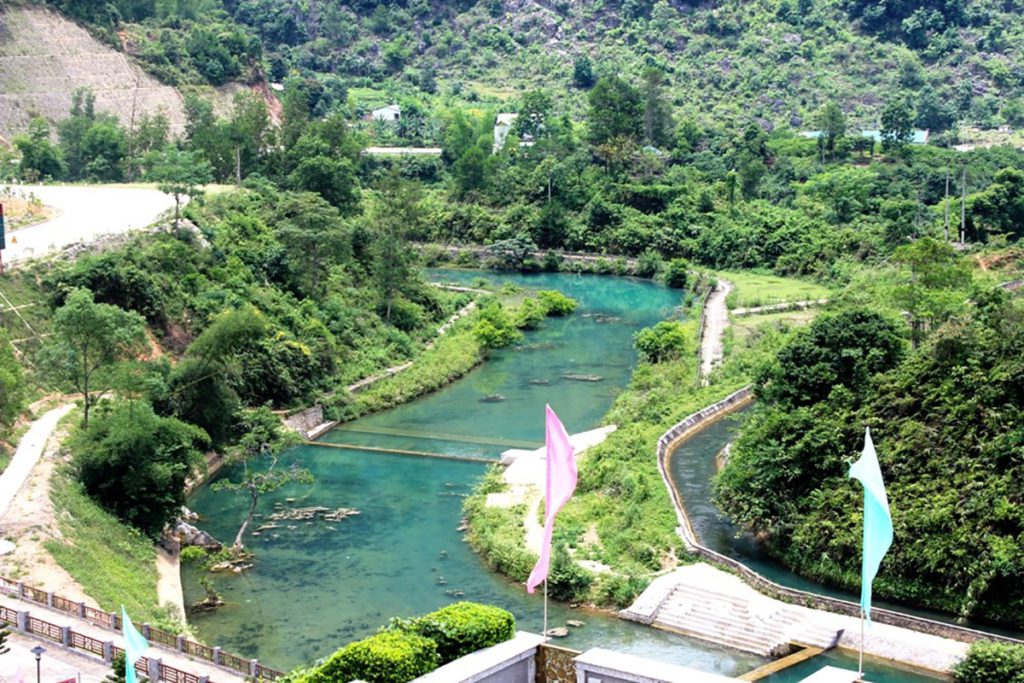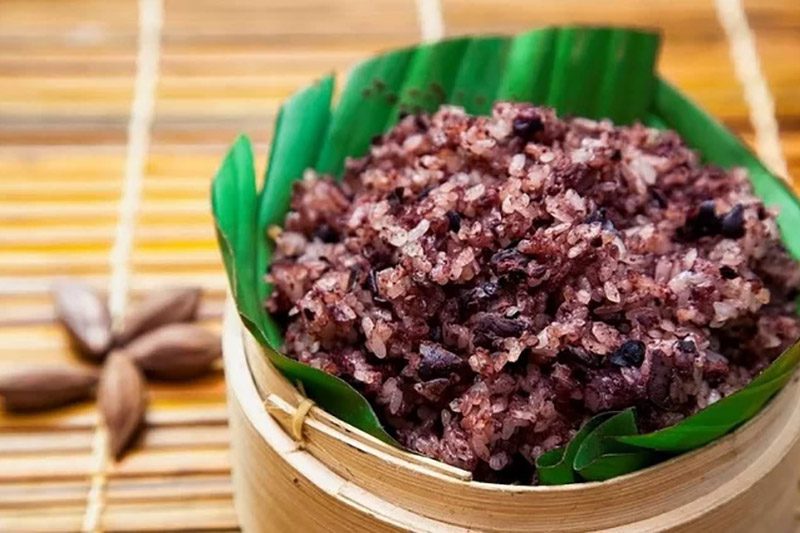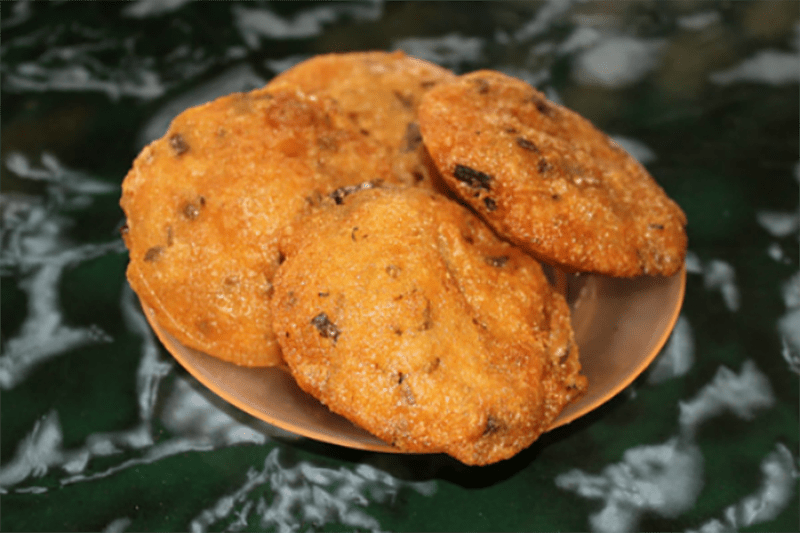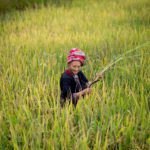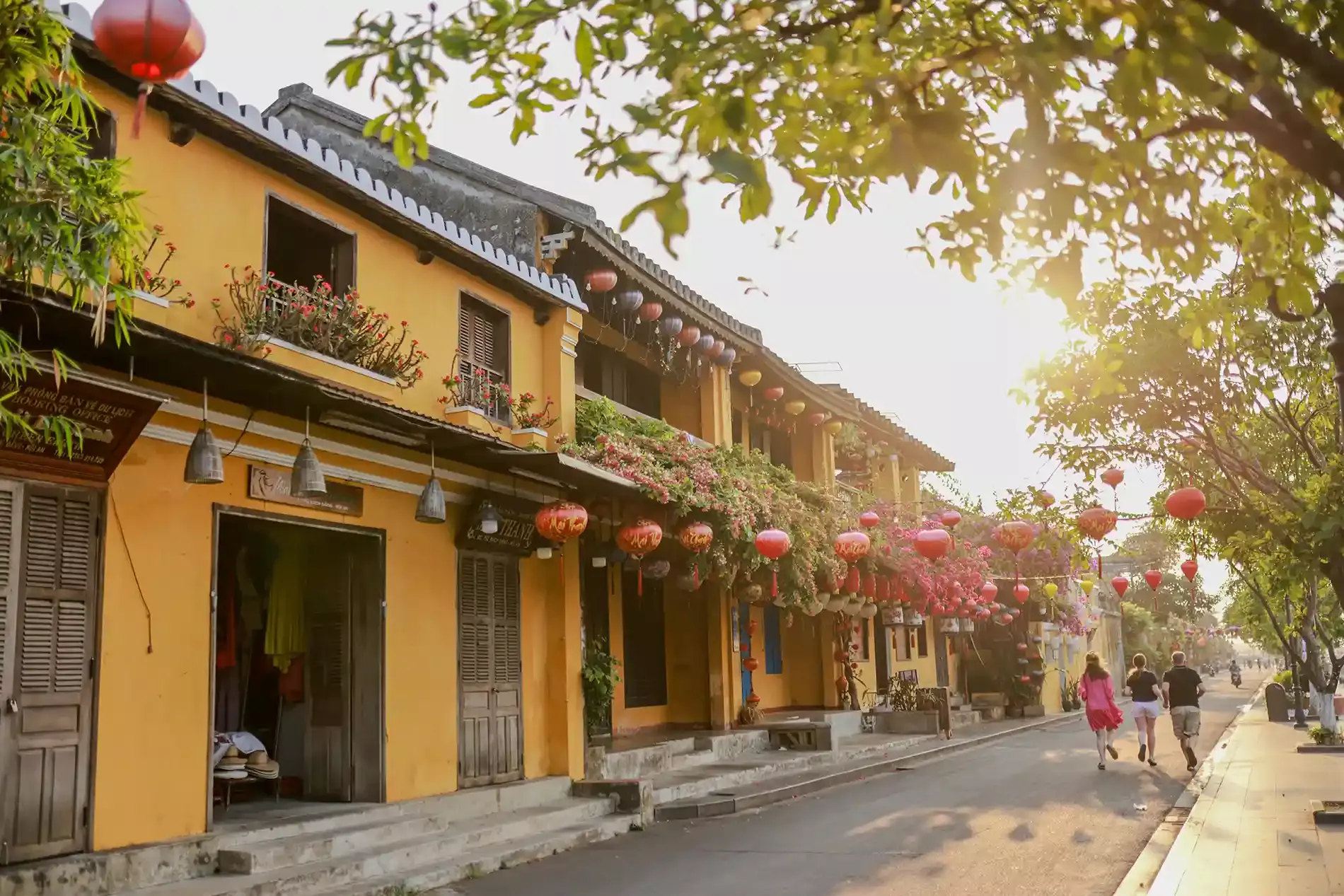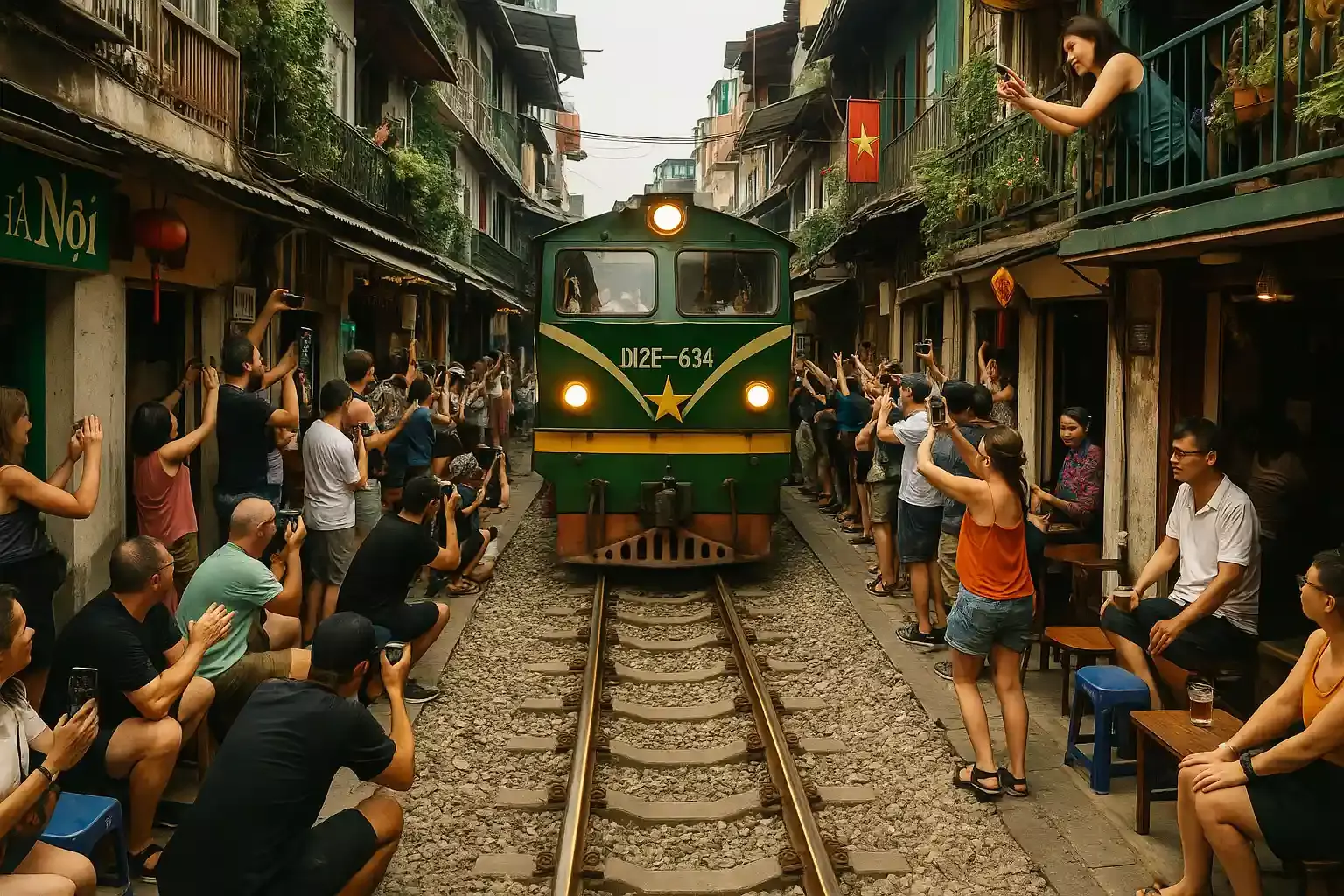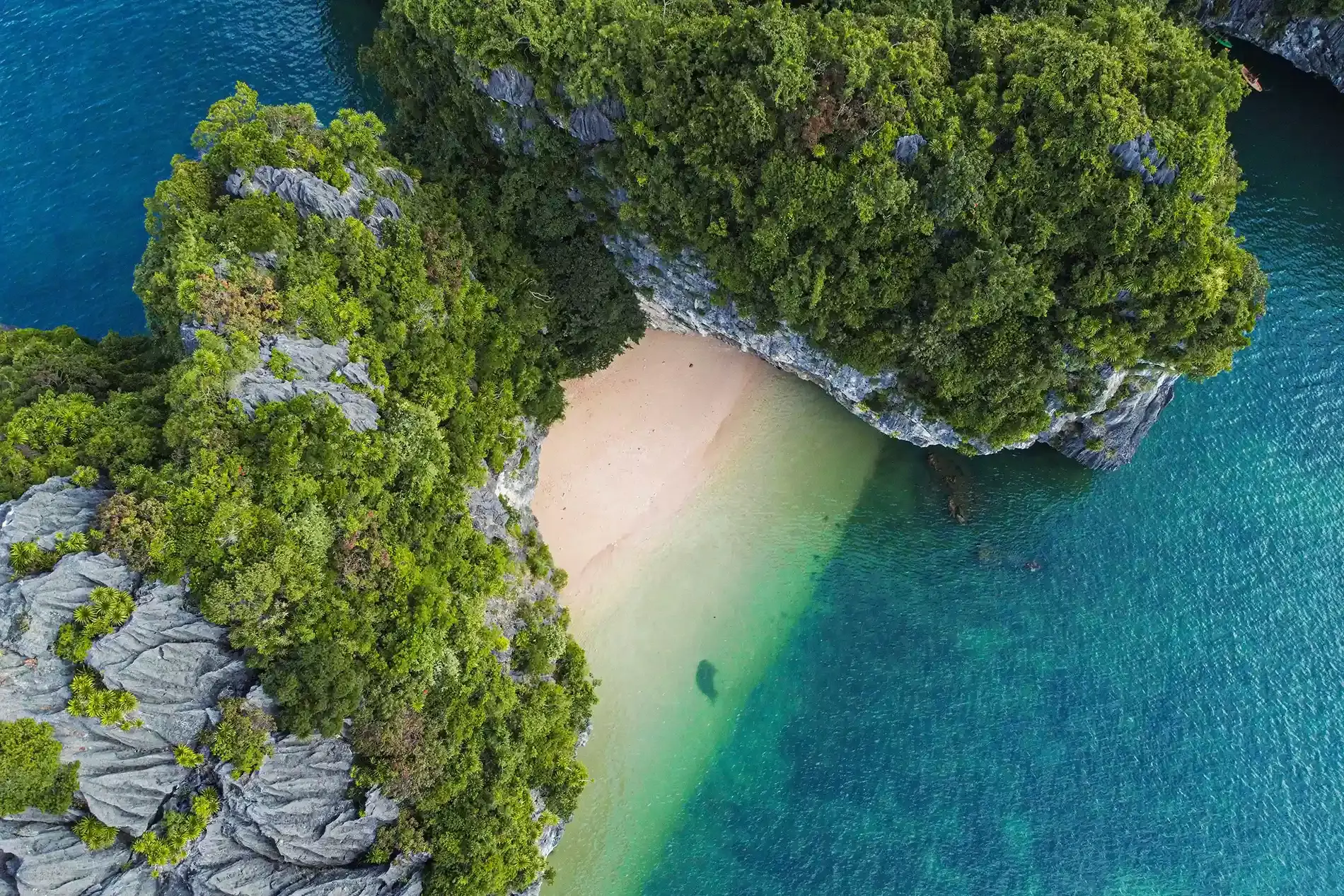
Cao Bang – the ultimate travel guide to a spectacular region of Vietnam
In this article, we invite you to explore Cao Bang, a fascinating region located in the extreme northeast of Vietnam. You will find practical information and our top 10 destinations to visit in the province.
We suggest to our travelers to combine their visit to Cao Bang with that of Ha Giang, the neighboring province, which offers equally spectacular landscapes.
Table des matières de l'article
Introduction to Cao Bang
Cao Bang, magnificent natural landscapes
The province of Cao Bang is a fascinating destination brimming with natural beauty. Known for its spectacular mountainous topography, Cao Bang offers travelers breathtaking landscapes. The majestic limestone mountains, lush green valleys, winding rivers, and picturesque waterfalls create a stunning backdrop for nature enthusiasts.
The region is home to, for example, the Non Nuoc Cao Bang National Park, a UNESCO World Heritage-listed nature reserve. The park is renowned for its diverse ecosystems, mysterious caves, and unique karst formations. Hikers can explore picturesque trails winding through dense forests, passing through terraced rice fields and discovering incredible flora and fauna. Geology enthusiasts will be amazed by the Nguom Ngao and Ban Gioc caves, where spectacular stalactites and stalagmites have formed over millennia.
Aerial view of Cao Bang. Credit : Mathieu Arnaudet
Cao Bang, the cradle of vietnamese resistance
Beyond its natural beauty, Cao Bang is also a place steeped in history and culture. The province is home to several historical sites, including Pac Bo Cave, which served as Ho Chi Minh’s refuge during the war against the French. Visitors can explore the various caves and gorges that served as guerrilla bases for Ho Chi Minh and learn more about the history of the struggle for Vietnamese independence. The mausoleum of Kim Dong, a young national hero, is also an important pilgrimage site for the Vietnamese
Cao Bang, a multi-ethnic region
The inhabitants of Cao Bang belong mainly to the Tay, Nung, and Hmong ethnic groups, making it an ideal destination for travelers interested in the cultural diversity of Vietnam. Visitors can stay in traditional villages, explore local customs, taste delicious regional cuisine, and participate in lively festivals that showcase craftsmanship, music, and traditional dances. One should not forget the Black Lolo ethnic group, living near Bao Lac, in the far west of the province.
Top 10 activities to do in Cao Bang
Ban Gioc Waterfalls
The Ban Gioc Waterfalls, located in the Cao Bang province of Vietnam, are one of the most stunning natural wonders in the country. Nestled on the border between Vietnam and China, these majestic waterfalls are among the largest and most spectacular in Southeast Asia. The turbulent waters of the Quay Son River cascade from a height of over 30 meters, creating a powerful waterfall that crashes into a picturesque landscape.
The Ban Gioc Falls are surrounded by lush vegetation, karst mountains, and vibrant terraced rice fields, creating a scene of breathtaking beauty. The contrast between the vibrant turquoise waters of the waterfall and the intense greenery of the surrounding nature forms a striking tableau that captivates visitors.
One distinctive feature of Ban Gioc Falls is that they are divided into three different levels. Each level offers a different view and a unique experience. Visitors can stroll along well-maintained trails to admire the waterfall from various angles, refresh in the clear waters of the river, or rent a bamboo boat to get closer to the falls and feel the power of the crashing water. The deafening sound of rushing water, refreshing splashes, and the peaceful atmosphere make the visit to Ban Gioc Falls a memorable experience.
Practical Information:
Entrance Fee: 20,000 VND/person (80 cents)
Boat ride for a closer view of the waterfall (and the Chinese!): 50,000 VND/person
Ban Gioc waterfalls. Credit : Mathieu Arnaudet
Nguom Ngao caves (tiger caves)
Located just 4 kilometers from Ban Gioc Falls, the Nguom Ngao Cave is one of the most impressive underground wonders in the Cao Bang province. Discovered in 1921 by French and Vietnamese administrators, it was nicknamed the ‘Tiger Cave’ in the language of the Tay ethnic group because, according to legend, tigers used to inhabit it.
The cave is very large, and you’ll need to walk 2 kilometers to complete the circuit. You’ll be impressed by the height and grandeur of the surroundings. However, the cave’s lighting is relatively poor – especially compared to caves like Phong Nha Ke Bang – mainly in yellow hues. The province is still in its early stages of promoting tourism, especially to Western tourists, and it’s likely that the hospitality and presentation will improve in the future.
Practical Information:
Entrance Fee: 35,000 VND/person.
Nguom Ngao cave. Credit : Mathieu Arnaudet
Phat Tich Truc Lam pagoda
Inaugurated on December 15, 2014, the pagoda was built on a total area of 3 hectares, nestled against the Phia Nham mountain, just 500 meters from Ban Gioc Falls. From the pagoda, visitors can contemplate the entirety of Ban Gioc Falls surrounded by rice fields and mountain ranges.
The pagoda was designed in the traditional Vietnamese architectural style, with ironwood, traditional terracotta tiles, and old-style gables or parallel sentences in Vietnamese characters. The pagoda has a three-panel gate, a statue of Bodhisattva Avalokitesvara, a hall of the three realms, an ancestral temple, a temple of the Holy Mother dedicated to Lady Trieu and the Hung Kings, to Saint Tran Hung Dao, to Eden, to the garden of Alahat statues, and to the temple venerating the hero Nung Tri Cao, who played a major role in defending the northern border of Vietnam. The highlight of the temple is the Thien Bao bell tower with a bronze bell weighing 1.5 tons.
Phat Tich Truc Lam pagoda in Cao Bang
Phong Nam valley
You’ll see it on the road; Cao Bang still boasts absolutely beautiful and largely undiscovered places. One such gem is the Phong Nam Valley, which you can explore with your guide. It’s a magical setting rarely visited by tourists.
The Quay Son River meanders through the valley, originating in China and then traversing the landscapes of Vietnam. This river, along with the rice fields and towering jungle-clad mountains on either side, gives the region a fairy-tale ambiance. Especially during the harvest season, also known as the golden season, when the rice fields turn a golden yellow, the views along the way are breathtaking.
There are two things to do in the valley:
- Take a stroll along the paths to the end of the valley to enjoy the waterfall (about 3-4 kilometers if you start at the beginning of the valley).
- Hike up to the viewpoint, which takes about 1 hour. The trail is not easily accessible, and it’s preferable to do it with a guide who can precisely locate the trailhead.
The valley is beautiful all year round, but if you want to see it during the ‘golden season’ – the harvest season when the rice fields are all a golden yellow – choose late September and early October. The months just before (July and August) also offer stunning landscapes when the rice is still green
Phong Nam valley. Credit : Mathieu Arnaudet
Nui Thung mountain
Coming from the city of Cao Bang and driving north towards Ban Gioc, you pass through the Ma Phuoc Pass, then take the DT205 road. After 10 km on this road, you’ll find a small road on your left that leads you through a mountain to the stunning hidden valley of Tuyet Tinh Coc.
The Nui Thung Mountain, also known as the Angel’s Eye Mountain, is still a lesser-known location, just 30 km from the city of Cao Bang and 70 km from Ban Gioc Falls. It’s not just the mountain that is worth the excursion, but the entire region, with Thang Hen Lake (see below), villages, mountains, and rice fields, all situated in a hidden valley called Tuyet Tinh Coc.
The mountain is thus called the Angel’s Eye, and it’s easy to see why. You’ll immediately notice a huge hole running through the mountain before its summit!
Around the mountain, you’ll find vast plains and lakes. There are 36 emerald lakes connected to Nui Thung Mountain, and the nearest one is called Thang Hen Lake. There’s also a small waterfall called Nam Tra Waterfall. It’s a favorite spot for locals to camp and fish, depending on the water level in the lake in front of Nui Thung
Nui Thung mountain in Cao Vang
Thang Hen lake
Just a 10-minute drive from Nui Thung, you’ll find Thang Hen Lake surrounded by beautiful jungle and mountains. It is part of this system of 36 lakes, each separated by several hundred meters and all located in the same valley. At 2 km long and 500 meters wide, Thang Hen is the largest lake of them all. The mountains and jungle surrounding the lake complete the impressive landscape. Unlike most other lakes in Vietnam that turn brown during the rainy season, Thang Hen Lake remains blue all year round as it is fed by clear and pure water from a cave located above the lake.
To access the lake, you’ll need to pay an entrance fee of 30,000 dong per person at an abandoned resort. Then, there is a road that goes around part of the lake that you can walk or drive. You can further explore the lake by taking a boat tour. There is also a restaurant where you can have lunch, dinner, or even find accommodation for an overnight stay.
Thang Hen lake in Cao Bang.
Phia Oac National Park
The national park spans across the communes of Thanh Cong, Quang Thanh, Phan Thanh, Hung Dao, and the city of Tinh Tuc in the Nguyen Binh district. The park has a total area of over 10,500 hectares, with its highest point reaching nearly 2,000 meters above sea level. Phia Oac – Phia Den National Park offers a fantastic wild natural landscape.
Preserving a pristine forest ecosystem in the high mountains, the national park is home to nearly 2,000 species of rare animals and plants, many of which are listed in the World Red Book.
As the first recognized national park in the Cao Bang province, it will play a crucial role in preserving and promoting sustainable development of the mountainous forest ecosystem while fostering local socio-economic development, security, and defense.
Phia Oac – Phia Den National Park is located within the Non Nuoc Cao Bang Geopark system, which has been acknowledged as a new member of UNESCO’s Global Geoparks Network
Phuc Sen blacksmithing village
The forge village of Phuc Sen is located in Phuc Sen commune, Quang Uyen district, Cao Bang province. This place has long been famous throughout the country for its traditional forging tools. It is closely linked to the life of the Nung people and has become a strong cultural feature of this region.
The commune consists of 10 villages with over 400 households and more than 2,000 residents, mainly people of the Nung ethnic group wearing typical indigo clothing. The main road of the commune has been paved, but the stilt house model and the lifestyle of the residents remain virtually unchanged.
The forging activity in Phuc Sen has existed for over 1,000 years, passed down from generation to generation to the present day. Currently, there are about 150 family blacksmiths, spread across 6 hamlets: Phia Chang upstream, Phia Chang downstream, Dau Co, Pac Rang, Tinh Dong, and Lung Vai, forming the famous forge village of Phuc Sen.
What is special here is that the artisans only forge handmade items, mainly based on their long experience. Everything is done manually, from the selection of materials to the steel processing. The blacksmiths not only produce knives but also scissors, hoes, sickles, etc., all of good quality and highly appreciated.
Villagers at work in Phuc Sen. Crédit : Mathieu Arnaudet
Black Lolo village in Bao Lac
Originally from southern China, the Lolo belong to the Tibeto-Burman family, also known as the Yi people. After being displaced from China by the imperial court in the 18th century, many Lolo clans chose to settle in Vietnam. Today, they are one of the smallest ethnic groups in Vietnam, numbering around 1,800 people, and primarily reside around the highlands overlooking Bao Lac in the northwest part of Cao Bang province.
You can stay in the village of Khuoi Khon, where the Lolo population lives, and where a recently built guesthouse is run by a Tay woman and her Kinh husband. Accompanied by your local guide, you can first climb to the viewpoint to get a panorama of the region. For those who want to hike further, you can visit the villages and learn more about the ancestral crafts of the Lolo and Hmong people, such as weaving, spinning, and textile dyeing techniques.
Black Lolo woman at work. Crédit : : Mathieu Arnaudet
Pac Bo historical site
Pac Bo is a historical pilgrimage site for many Vietnamese. After Hồ Chí Minh crossed the border between China and Vietnam in 1941, Pac Bo became a place that will forever be engraved in Vietnamese history. In this relatively small area, you will find the cave of Hồ Chí Minh, better known in Vietnamese as ‘Hang Cốc Bó.’
It was in this cave that the revolutionary leader spent his first weeks back in Vietnam, protecting himself from his enemies and organizing the rebellion. The so-called ‘Lenin Stream’ flows next to this cave, a stream with clear blue water.
As a pilgrimage site, it is also a place that people from the province cherish for picnics and spending quality time with family.
The ticket price to enter the cave is 20,000 VND per person.
Pac Bo historical site.
Practical information about Cao Bang
How long staying in Cao Bang ?
It will, of course, depend on what you want to visit. If you plan to visit all the sites described above, you will need 4 to 5 days to take your time, especially if you are traveling by motorcycle, for example. The landscapes are stunning, and you will make many stops along the way. If you go on a tour, it will probably be combined with Ha Giang. In that case, there will likely be 3 days in the Cao Bang province.
How to get there ?
There are several options:
By bus from Hanoi: There are several bus companies departing from My Dinh station to Cao Bang. The journey takes between 6 and 8 hours.
By bus from Ha Giang: For those who want to continue their journey after visiting Ha Giang, you can take a bus from Ha Giang city to Cao Bang. You have the option of taking local buses (from the bus station) or tourist buses (from your hotel). It’s a mountainous road, and it will take between 8 and 10 hours to reach your destination!
By private car: This is, of course, the most comfortable option, allowing you to stop wherever and whenever you want. You have two options: either hire the services of a driver and predefine the stops. Or, and this is what we suggest, book a private tour where you will be accompanied by a French-speaking guide. Your guide will enable you to interact with the locals, which is necessary for an authentic and immersive travel experience.
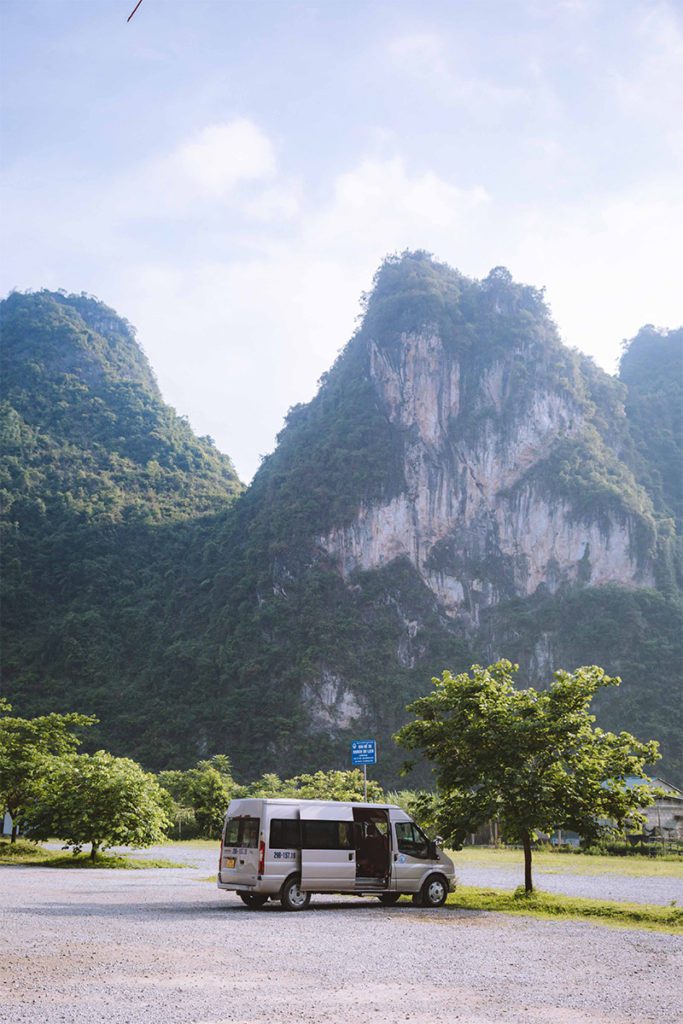
Bus waiting at Tiger cave parking. Crédit : Mathieu Arnaudet/Parfum d’Automne
When to go to Cao Bang ?
The mountainous and cool climate of Cao Bang province makes it an ideal destination in summer, from June to October. However, the stunning nature with its forests, mountains, and waterfalls is also beautiful in spring, from February to April. During this season, you’ll avoid the monsoon rains.
Finally, if you’re not afraid of the cold and want to see snow-capped mountains in Phia Oac National Park, it’s best to visit here from November to January.
Accommodation in Cao ?
It will depend on the destinations.
Next to Ban Gioc Falls, we can recommend Lan Homestay. It’s a traditional stilt house homestay ideally located between the mountains and a river.
In Cao Bang, we recommend two accommodations:
- Jeanne Hotel: A hotel located in the center of Cao Bang city. Good service and beautiful rooms.
- Max Boutique Hotel: A superb hotel with comfortable beds and nicely decorated rooms.
Finally, in the village of Khuoi Khon, where the Black Lolo ethnic group lives, we can only recommend Khuoi Khon Homestay, which is a beautiful guesthouse with private rooms. It’s new, well-decorated, and has a superb view. Please note that the toilet and shower facilities are shared.
Khuoi Khon homestay. Crédit : Mathieu Arnaudet
What to eat in Cao Bang ?
Here are some dishes that are typical of the province:
Banh cuon Cao Bang: Banh cuon, or steamed rice rolls, is served in Cao Bang with a bowl of bone-based broth containing Vietnamese pork sausage called cha lua, as well as egg, instead of the small bowl of fish sauce commonly found in other regions of the country. Therefore, the dish is also called “steamed rice rolls in soup” to distinguish it from its counterparts in other regions. Culinary adventurers can also add tuong ot mang chua mac mat, a mixture of bamboo shoots, clausena leaves, and spicy sauce.
Banh Cuon Cao Bang.
Xoi tram or Sticky Rice: Xoi tram, or sticky rice mixed with whole fruits from the harde tree. This tree only produces its iconic black fruits in the autumn. Locals soak the fruits in hot water to soften them, remove the skin and seeds, and then mix the pulp with cooked sticky rice to give it a pink and violet color. The fragrant sticky rice has a rich taste.
Le xoi tram ou riz gluant
Banh ap chao or Fried Duck Cake: This is a popular street food. The crust is a mixture of rice flour, glutinous rice flour, and soybean. Locals use newly harvested rice, soak it in water for half a day to soften it, then grind it into flour. Soybeans and egg yolks are added to the flour to make a paste. The filling is prepared from deboned and marinated duck meat, similar to roasted duck. Then, the cake is fried in a large wok with hot oil and flipped until it is golden on both sides.
People enjoy this cake during cold periods. Locals say that the banh ap chao season is between November and February when the aroma of the cake fills the streets.
Banh ap chao.
Vit quay bay vi, or Seven-Flavor Roast Duck: The seven flavors refer to seven spices and condiments used to marinate the duck: ginger, garlic, dried onion, pepper, honey, tofu, and dried clausena leaves (mac mat in Vietnamese) that grow in the forests of Cao Bang. Then, the duck is roasted to achieve a crispy golden skin on the outside and tender meat on the inside.

Vit quay bay vi.
What to do after Cao Bang ?
As we have seen, the Cao Bang region is often visited in combination with Ha Giang. In fact, our 7-day itinerary will take you to explore these two fantastic regions and also introduce you to Ba Be Lake, a peaceful haven.

